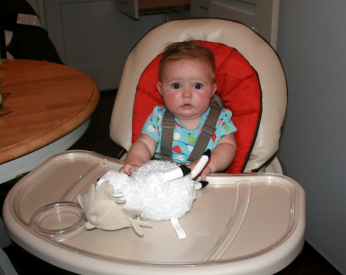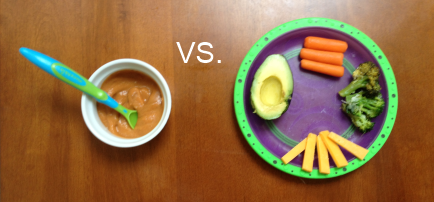Starting Solids Introduction
In a few weeks, you’ll likely be sent home from your baby’s 6-month well-baby checkup with a blessing from your pediatrician about starting solids. Yay, fun!
You’ll go home and realize that you have NO idea what the hell you’re doing. I mean, shouldn’t the doctor give you an instruction manual — or something?!
The bad news is… there is no official manual for this endeavor. The good news is, it doesn’t really matter! Yes, there are many different ways to skin this cat.

First, some background info:
When to Start
- Breastfed babies: 6 months (give or take)
- Formula-fed babies: 5 to 6 months (or, as soon as readiness cues are given, read below)
- *Since formula-fed babies are not routinely exposed to a variety of flavors and smells, they are encouraged to start solids a little earlier in order to maximize flavor exposure during the first-year-window-of-food-acceptance-opportunity-thing (more below).
These are general rules of thumb; of course, there are always exceptions. If you started early or want to wait a little longer (but not too long), it’s all good. Pediatricians are all over the board on this as well – some will recommend starting solids as soon as four months, especially the old-timers.
Readiness Cues
You can start on the earlier end (i.e., closer to 4 months) if your baby is showing signs of readiness. These include:
- Sitting up/holding her head up (do you eat lying down? Me neither.)
- Reaching for and showing interest in your food
- Being able to pick up a small item with her pointer finger and thumb and put it in her mouth
While your own mother may have started feeding you on rice cereal as early as six weeks (“and you turned out just fine!”), there’s good reason to wait as long as you have:
Maturity of the digestive system
Between four and seven months, small spaces in a baby’s intestinal lining close completely and the digestive tract becomes more selective about what gets through. Before the intestinal lining properly closes, it’s possible (in theory) for potentially allergenic food molecules to enter the bloodstream. Once food molecules are in the blood, the immune system may produce antibodies to that food, creating a [preventable] food allergy.
*If you’re interested, there are opposing views on this issue: one camp believes in the notion of a “virgin gut,” while the other doesn’t. If you can stomach the nitty-gritty scientific details on “intestinal permeability,” check out this page to learn more about the “pro” argument and this blog post to learn more about the “nay” argument. **Either way, your baby’s stomach isn’t ready for solid foods before 4-6 months, so don’t stress out too much about this. Go with your gut. (Get it?)
Tongue-thrust reflex
The tongue-thrust reflex helps prevent babies from choking. This reflex causes the tongue to push food out of the mouth, rather than back into the mouth. From 4-6 months, this reflex gradually diminishes, giving that spoonful of sweet potatoes a fighting chance of making it through.
Months 6-12, at a glance
In the early months, the concept of starting solids really just means augmenting your baby’s regular milk or formula with food. Over the course of this half year, he will naturally decrease his milk/formula intake as he begins to receive (more) sufficient caloric intake from solid foods. Only toward the end of his first year will you notice him eating in patterns more similar to yours (eating three regular meals a day, getting milk/formula as needed).
For simplicity’s sake, let’s divide this into four not-so-distinct phases:
1. The Exploratory Phase: ~6 months (lasts about a month from whenever you start[ed])
This is a fun time of exploring new flavors, textures, and smells. We’re also getting used to sitting in a high chair and getting acquainted with bowls, bibs, and other appurtenances. Don’t expect your baby to get any significant calories from food during this phase; this first month is really just an intro. For the most part, he will continue to consume the same amount of milk or formula as before (sorry, boobs, you’re not off the hook yet). *If you are a subscriber, you’ll receive an email about this phase just before the 6-month mark.
2. Flavor Immersion: 7-9 months
During this phase, we’ll move to a regular, 3x-a-day meal schedule as baby starts consuming larger quantities of food. We’re focusing on variety and adoption of healthy foods by repetition (more on this later). We’ll also introduce a sippy cup during this phase.
3. Finger Feeding: 10-12 months
Baby should begin self-feeding during this phase, if he hasn’t already. In this phase, we focus on hand-held foods that can be self-administered. You can begin to introduce utensils if you think your babe is ready. He should be eating a wide variety of foods by this time. Breastfeeding (or bottle feeding) will occur less frequently.
4. Regular Eating: 12+ months
By 12 months, your baby should be eating three regular meals a day, just like you, and snacking as needed. By this point, you’ll want him to be completely weaned off the bottle, if he’s not already. Nursing moms will be breastfeeding less frequently, as baby is deriving more and more calories from food.
Choosing Your Approach: Baby Food vs. Baby Led Weaning
Traditionally, most Americans start by feeding baby food, which is food that’s been pureed into mush: sweet potatoes, bananas, rice cereal, etc. You can easily make these foods at home or you can buy them at the store. Store-bought baby foods are usually classified into three main categories: Stage 1 is a thin puree, Stage 2 is a little thicker, and Stage 3 usually contains chunks-of-stuff. When shopping for store-bought baby food, be aware of possible heavy metal contamination.
Babies are typically spoon-fed for several months until they are able to feed themselves.

Another approach that’s become more popular as of late is called “Baby Led Weaning” (BLW, for short). Don’t let the fancy name confuse you. In a nutshell, baby-led weaning simply means that you bypass the spoon-feeding-of-purees stage and allow your baby to self-feed finger foods as his motor skills allow him.
There are pros and cons to each.
The big advantage to feeding baby food is that you can puree just about anything. Meaning… you have leftover carrots, hamburger, and broccoli from dinner? Great, throw it in the blender annnnd… done. In fact, you can whip up anything you can dream up. With BLW, you have to feed foods that your baby can actually grab and chew (gum?). Bottomline: with purees, you can expose your baby to a wider variety of foods.
On the flipside, the advantage to BLW is that you don’t have to worry about buying, making, (or containing, storing, freezing…) baby food (though you may be steaming a lot of fruits and veggies), since you are simply feeding her normal table food. This may indeed simplify your life. You also don’t have to spoon-feed your baby at every meal, which can be frustrating, messy, and time consuming. Also, BLW babies fine-tune their motor skills a bit earlier, with many learning to use utensils by the 12-month mark. (By the way, scientists are just starting to weigh these approaches against one another, and so far they’ve determined pretty much the same thing as any open-minded, observant parent… both have pros and cons. There is no “superior method,” so just do what works best for you and your family.)
Case in point: Lucie, my first born, was very happy to be spoon-fed. She didn’t show much interest in self-feeding for the first few months. Alice, on the other hand, wouldn’t let me NEAR her with a spoon of puree. She ONLY wanted to feed herself, so we followed the BLW approach for her and have never looked back.
Point being: Your baby will probably be the one who decides how they want to eat. Your best bet is to follow her lead. Try a little of both. And by the way, it’s not an all-or-nothing thing, meaning – you don’t have to rigidly subscribe to one approach or the other. I always see women debating and defending their approach-of-choice on the baby boards. I mean, who really cares? Just follow the whatever works (“WW”) method and don’t get too hung up on it.
The Importance of Months 6-12
Your Job: Maximizing the “Try Anything” Window
There is a natural window of opportunity that exists during infancy; let’s call it the “try anything” window. It goes something like this: during infancy (before the second year of life), babies are naturally willing to taste and adopt new flavors, textures, and smells. Studies have shown that the earlier (and more often) a baby is exposed to a new food, the more likely he is to accept it in the long-term.
However, once toddlerhood begins, the “neophobic response” kicks in and kids suddenly become averse to new foods. In fact, even a slight variation of a familiar food (real apples vs. applesauce, for example) can result in rejection. Slam. This aversion peaks around 18 months, and during this time your child may even reject foods she previously accepted (crrrap, and you were doing so good!). It alwaaaays happens right around the time you are bragging to all your friends about how much your baby looooves vegetables – ha!
Why is this? Evolution, maybe: think back to our ancestors living in the woods. It would be quite dangerous, from an evolutionary perspective, for a toddling child to walk around the forest sampling new things (poisonous mushrooms, berries, etc.). Thus, the aversion to new flavors in toddlerhood may be a survival mechanism [who knows].
The bottom line is that you need to take full advantage of the first year to expose your child to as many flavors and textures as possible before this window closes. The mistake a lot of parents make is to introduce a small handful of easy (and usually bland) foods in the first year… then toddlerhood comes around and parents decide to expand their palate a bit, but new foods are promptly rejected without a second look.
“Children introduced to lumpy solids after the age of 9 months [as opposed to before] were reported as having more feeding problems at 7 years (e.g., food refusal and food ‘fussiness’).”
Coulthard, Harris, Emmett & Northstone, 2009
On this matter, if you snooze, you lose. If you want to reduce picky-eater-ness in your child, throw as many flavors and textures at them during the first year as you can. More on this later.
That’s a little preview of what’s to come. Get ready for some funnnn!
Thank you for the information you have provided!
appreciate your info and summary of BLW vs pureed foods! so hard to navigate all the options as a new parent, and your synopsis really helps!
Dear Lucien List
I really love and appreciate the information you share:) keep being awesome!
After many hours of searching through articles on the internet about feeding methods I finally feel calm and confident after reading yours!Thank you 🙏
First of all, thanks for this! Second (FTM/BF) I’m freaking out! He’s 8 months and I’m just starting purées! I’m trying to help him catch up.
Thanks for the info you shared I really love and appreciate!
I found the portion on food exposure during the first year to be very interesting, as my husband and I are foodies and want out baby to join in that with us. Do you have resources on this topic? Like, what age should babies be given spices, salt/sugar, sushi, tofu, etc?
Thanks!